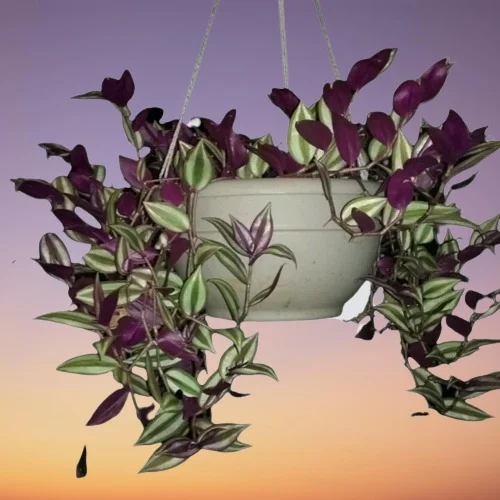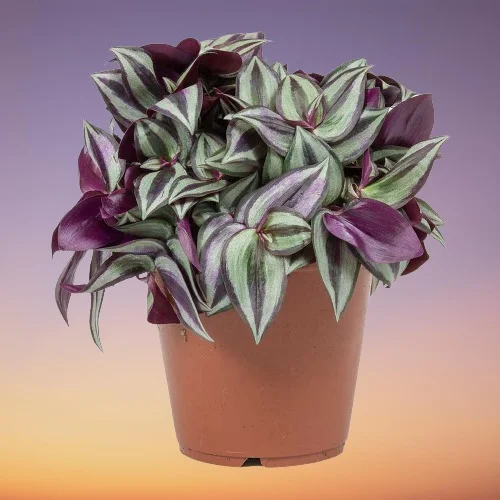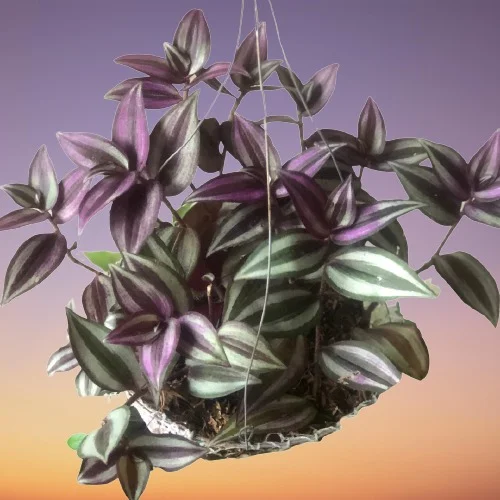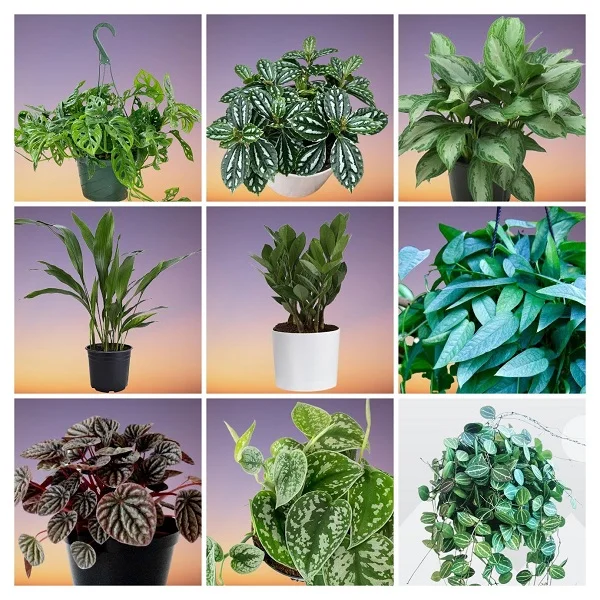Silver Inch Plant (Tradescantia zebrina) Indoor Care, Common Problems and Remedies
Some links in this post may be affiliate links
Silver Inch Plant (Tradescantia zebrina) grows best in bright indirect light, average warmth, moderate humidity and moderately moist, rich, well-drained soil coupled with fortnightly feeding in the growing season.
Tradescantia zebrina is one of the popular Tradescantia varieties that will withstand a wide range of growing conditions and easily propagates as just a node of this plant will sprout into a beautiful plant in no time.
Silver Inch Plant bears glistened leaves which are multicolored above where the surface color is bluish-green, banded with silver and edged in purple placing it amongst the purple-leaved plants for any space.
Tradescantia zebrina leaves are fleshy, ovate, pointed towards the tips and rounded to the base. The flowers are pink to purplish.
Silver Inch Plant is among the fast-growing plants bearing trailing stems and an attractive foliage which looks spectacular in a hanging basket, on a tabletop, plant shelf and other places where it can beautifully hang downwards.

Botanical name: Tradescantia zebrina
Synonyms: Zebrina pendula, Tradescantia pendula
Family: Commelinaceae
Common name: Silver Inch Plant
Origin
Tradescantia zebrina also called Zebrina pendula or Tradescantia pendula is native to Mexico, Central America, Columbia and some Caribbean Islands. It has been naturalized in parts of Asia, Africa, Australia, South America and various oceanic islands. In its native habitat, it grows in thickets in the wetlands and rainforest, often on stones in shady and open areas or on riverbanks.
How big do Silver Inch Plants get?
Silver Inch Plants are fast growing plants whose stems can grow to 3 feet long within a short period.
Varieties
Some common varieties of Tradescantia zebrina are:
- Zebrina purpusii (Bronze Inch Plant) whose leaf surface is purplish-green with a purple underside.
- Zebrina pendula quadricolor which is more showy, bearing green, silver, pink and red leaf surface with a purple underside.
What are the benefits of Tradescantia zebrina?
- Low maintenance: It is great for beginners and busy plant parents.
- Fast propagation: Easy to multiply from just a node.
- Visual appeal: Its vibrant colors add character to neutral interiors.
Invasiveness as a weed
Tradescantia zebrina is an invasive and noxious weed in many places. The plant will successfully grow anywhere and will smoother ground level plants and prevent the natural regeneration of taller species.
Avoid planting the plant in the ground and dispose only after complete destruction as even an inch of this plant will sprout if not completely destroyed. It is one of the hard to kill plants and will survive in less than perfect growing conditions.
Is Tradescantia zebrina poisonous?
Yes. Tradescantia zebrina is mildly toxic to humans and pets. If ingested, the plant sap can cause burning in the mouth, tongue and throat. The sap may also cause skin irritation in sensitive skin; always wear gloves when handling the plant.
Where to Buy
Silver Inch Plants are magnificent plants to add to your collection. You may get them online from Etsy (Link to Etsy).

How do you care for Silver Inch Plant indoors?
Caring for Silver Inch Plant indoors entails providing bright indirect light (filtered light), average warmth of 16-270C, humidity of 50-55% and moderately moist, fertile, well-drained soil coupled with fortnightly feeding during the growing season.
Tradescantia zebrina care requires regular pruning to keep it neat, to reduce pest and disease infestations, to encourage a bushy, compact growth and to rejuvenate growth. Repotting is only needed when extremely pot-bound as it grows best when slightly root-bound. Keep reading for more on these growing conditions and how to achieve them.
Light Requirements
How much light does Tradescantia zebrina need?
Tradescantia zebrina prefers bright indirect light (dappled light). Put it near a large, brightly-lit window but away from direct sunshine to prevent scorching of the leaves.
Too little light results in faded colors and leggy stems. You may use grow lights if the natural lighting is not adequate.
Regularly turn the pot to ensure that the plant receives light on all sides for uniform growth as well as prevent leggy growth.
Watering
How often should I water Tradescantia zebrina?
Water Tradescantia zebrina thoroughly in spring and summer while allowing the top 2-3 inches of soil to dry out between waterings. Maintain the soil moderately moist and avoid soggy soil to prevent yellowing and leaf drop.
Decrease watering in fall and winter to keep the soil slightly moist as growth is minimal. Do not allow the soil to dry out completely to avoid wilting and yellowing.
Confirm that the pot has a drainage hole and the soil is well-draining to prevent waterlogging which can lead to root-rot and death of the plant.
Temperature and Humidity
Tradescantia zebrina flourishes in an average warmth of 16-270C. A room temperature that is comfortable for you is ideal for this plant. Keep it away from drafts emanating from AC units, drafty windows, heat sources, windy doors among others as they can cause stunted growth and leaf drop.
Silver Inch Plant thrives in a humidity of 50-55%. Too low humidity may result in brown, shrivelled leaf tips. Therefore, set the pot on a wet pebble tray, use a humidifier or group the plants together to upscale humidity. Maintain proper air circulation to minimize fungal diseases.
Fertilizer
What is the best fertilizer for Silver Inch Plants?
Feed Silver Inch Plant with a balanced, liquid fertilizer every 2-4 weeks in spring and summer for lush growth. Do not feed in fall and winter as the growth is minimal and feeding at this time may lead to fertilizer burn.
Potting Soil
What kind of soil does a Silver Inch Plant need?
The best soil for Silver Inch Plant is a rich, well-draining potting mix to prevent it from getting soggy while providing the required nutrients. A mix of 50% all-purpose potting soil, 25% perlite or pumice, and 25% coco coir or peat moss is ideal for this plant.
Repotting
When to repot Silver Inch Plant?
Repot Silver Inch Plant during the growing season (spring to early summer), only when the plant has become extremely pot-bound.
How to repot a Silver Inch Plant?
- Water the plant thoroughly at least 1 day before as a well hydrated plant suffers less transplanting shock and takes a shorter time to take root.
- Select a pot one size larger and ensure it has a drainage hole to prevent the soil from getting soggy. Check out these ceramic pots with drainage holes on Amazon.
- Fill the pot a third way full with well-draining soil and slightly moisten the soil.
- Gently, slip the plant from its pot, shake off the soil from the rootball and cut away any dead roots.
- Place the plant in the center of the pot and continue filling with the soil while firming it around the base. Maintain the plant at the same soil level as it was in the previous pot.
- Wet the soil thoroughly and replace the plant to its usual position.
Pruning & Grooming
Pruning Silver Inch Plant involves:
- Regular removal of dead foliage to maintain the plant neat and tidy as well as discourage pest and disease infestations.
- Pinching off the growing tips to control the growth and encourage bushyness.
- Cutting back leggy stems at the beginning of the growing season to rejuvenate growth.
Clean the leaves by damp-wiping with a soft cloth to get rid of dusts as well as minimize pest and disease infestations.
Tradescantia zebrina Propagation
Tradescantia zebrina (Silver Inch Plant) is propagated at the beginning of the growing season by plant divison or from stem cuttings which you can root in water or in soil.
Learn how to propagate Silver Inch Plant (Tradescantia zebrina) in 3 easy ways.

Tradescantia zebrina Problems & Solutions
What problems can Tradescantia zebrina have?
Tradescantia zebrina (Silver Inch Plant) problems are brown leaves, plant dying, falling leaves, brown and crispy leaf tips, yellow leaves, leggy growth, dull leaves, pests and diseases among others. Keep reading for more on these problems and how to fix them.
Brown leaves
Why are the leaves on my Tradescantia zebrina turning brown?
The main causes of brown leaves on your Tradescantia zebrina are inconsistent watering, soggy soil, and extreme temperatures.
How to fix it
Inconsistent watering: Do not water on a schedule. Water when the top 2-3 inches dry out. Never allow the soil to dry out completely.
Soggy soil: Use a pot with a drainage hole and well-draining soil.
Extreme temperatures: Keep the plant away from drafts coming from AC units, drafty windows, heat sources, windy doors and others.
Plant dying
Why is my Tradescantia zebrina dying?
Your Tradescantia zebrina is dying due to root-rot disease which is enhanced by soggy soil and is characterized by yellowing and wilting leaves, rapidly followed by browning and plant collapse.
How do you revive Tradescantia zebrina?
- Carefully slip the plant out of its pot and inspect the roots.
- Trim the brown-black, mushy roots and treat the healthy roots with a copper-based fungicidal solution as indicated by the manufacturer.
- Disinfect the pot with the fungicidal solution or use a fresh pot to repot the plant in fresh, free-draining soil.
- Do not water the plant immediately and keep it dry for 5-7 days before you can resume watering.
- Use a pot with a drainage hole and well-draining soil to prevent the soil from getting soggy.
- Reduce watering in fall and winter as growth is slowed at this time; keep the soil slightly moist.
Falling leaves
Why are the leaves falling off my Tradescantia zebrina?
Leaves are falling off your Tradescantia zebrina due to too little light, drafts and improper watering.
How to fix it
Too little light: Move the plant to a brighter spot or instal a grow light if the natural light is not enough.
Drafts: Keep it away from sources of drafts like AC units, drafty windows, hot air vents, windy doors and others to maintain a warmth of 16-270C.
Improper watering: Water when the top 2-3 inches of soil dry and do not allow the soil to dry out completely.
Brown, crispy leaf tips
Why are the leaves on my Tradescantia zebrina turning brown and crispy?
Brown, crispy leaf tips on your Tradescantia zebrina is caused by dry air, temperature stress and underwatering.
How to fix it
Dry air: To up the humidity, set the pot on a wet pebble tray, use a humidifier, group the plants together or grow the plant in a well-lit bathroom.
Temperature stress: Keep the plant away from drafts to avoid extreme temperatures.
Underwatering: Do not allow the soil to dry out completely; water when the top 2-3 inches of soil feel dry.
Yellow leaves
Some of the causes of yellow leaves on Silver Inch Plant are overwatering, soggy soil, nutrient deficiency, and temperature stress.
How to fix it
Overwatering: Do not water on a schedule. Water only when the top 2-3 inches of soil dry.
Soggy soil: Use a well-draining potting soil and a pot that has a drainage hole.
Nutrient deficiency: Apply a balanced, water-soluble fertilizer every 2-4 weeks in spring and summer.
Temperature stress: Keep the plant away from drafts coming from hot surfaces, hot air vents, AC units, windy doors among others.
Leggy growth
Leggy growth on Silver Inch Plant is cause by too little light, underwatering, and overfeeding.
How to fix it
Too little light: Place the plant in a brighter spot as it needs bright indirect light or use a grow light where the natural light is not enough for the plant.
Underwatering: Maintain the soil moist in spring and summer and slightly moist in fall and winter. Never allow the soil to dry out completely.
Overfeeding: Feed the plant with a balanced, liquid fertilizer every 2-4 weeks in spring and summer.
Dull leaves
Dull leaves on Silver Inch Plant are due to low light. Position the plant in a brighter spot, where it will receive bright indirect light or instal grow lights if you do not have adequate light in your home.
Pests
Common pests for Silver Inch Plant are mealybugs, aphids and scale insects.
How to fix it
- Isolate the affected plant to prevent spread to the other plants and treat it with neem oil or insecticidal soap as per the manufacturers instructions.
- Regularly check underneath the leaves for these pests and carry out timely control measures.
- Keep the plant properly pruned and increase humidity to discourage pest infestation.
Diseases
Silver Inch Plant is prone to leaf spot disease which is indicated by brown patches surrounded by a yellow halo.
How to fix it
- Remove and burn the affected parts to reduce the risk of spread to the rest of the plants.
- Spray the affected plant with a systemic fungicide and ensure to cover all the parts with the fungicidal solution.
- Keep the plant on the dry side, do not mist it and ensure good air flow.
- Use a pot with a drainage hole and well-draining soil.
Conclusion
Silver Inch Plant (Tradescantia zebrina) care indoors brings both joy and elegance into your space. With minimal effort, you can cultivate a lush, colorful cascade of foliage that not only beautifies your home but enhances your connection with nature.
Whether you are snipping cuttings to propagate, fending off the occasional pest, or simply admiring its shimmer in the morning light; this plant rewards your attention with consistent beauty.
Frequently Asked Questions
1. Does Tradescantia zebrina need full sun?
No. Tradescantia zebrina needs bright indirect light. Full sun will cause scorching of the leaves.
2. How do you take care of Silver Inch Plant?
- Provide bright indirect light. Keep it away from direct sunlight.
- Keep the soil moderately moist in spring and summer and slightly moist in fall and winter. Do not allow the soil to dry out completely at any time.
- Maintain average warmth of 16-270C and a humidity of 50-55%.
- Feed with a balanced fertilizer every 2-4 weeks in spring and summer.
- Use well-draining soil and a pot with a drainage hole to prevent water logging.
3. How do you propagate a Silver Inch Plant?
Silver Inch Plant is propagated by plant division or from stem cuttings which can be rooted in water or in soil.
4. Can I grow Silver Inch Plant in water permanently?
Yes. You can grow Silver Inch Plant in water, but growth will slow down over time. Soil is best for long-term health.
5. How fast does Silver Inch Plant grow?
Silver Inch Plant grows rapidly during spring and summer, with noticeable length within weeks.
6. How do I make Tradescantia zebrina more purple?
Provide it bright indirect light; dim settings will dull its vibrant hues.
7. What diseases do Tradescantia zebrina get?
Tradescantia zebrina is prone to root-rot disease and leaf spot disease.
8. How do you make Tradescantia zebrina bushy?
- Regularly, pinch off the growing tips to control the growth and encourage bushyness.
- Cut back leggy stems at the beginning of the growing season to rejuvenate growth.
You liked it? Share on social media.
Related Content
Amazon Associates Disclosure
Homeplantsguide.com is a participant in the Amazon Services LLC Associates Program, an affiliate advertising program designed to provide a means for sites to earn advertising fees by advertising and linking to amazon.com.





